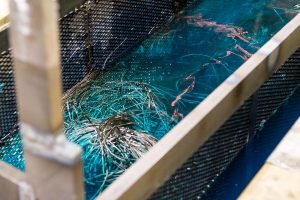
Credit: Pekka Niemi/Kuusakoski
Finnish recycling company Kuusakoski has refined its method for processing a key component of MRI machines and is now producing distinct streams of high-grade metals.
Most of the magnetic resonance imaging (MRI) machine can be dismantled and processed using traditional mechanical methods. But the coil inside the device poses some challenges for effective recovery. The coil is made up of copper and niobium-titanium alloy, which are encased in resin. Until recently, the standard recovery method has damaged the metals and produced some amount of pollution.
A new process recently developed and tested by Kuusakoski’s research and development team melts the resin using a pyrolysis furnace. In the furnace, the atmospheric conditions can be tightly controlled and the resulting metal stream comes out clean.
This gives the resulting metal “substantially better value,” explained Arsi Saukkola, R&D manager for Kuusakoski, in an interview with E-Scrap News this week.
Kuusakoski is heavily involved in e-scrap recycling in North America and Europe. It is known in the U.S. for a controversial CRT glass management process it has pushed forward at the site of a landfill in Illinois.
Extracting a superconductor
The coil in a helium-refrigerated core constitutes about 10 percent of the MRI, Saukkola explained, and contains about 1,000 pounds of wire. Most of that wire is copper, but about a fifth is niobium-titanium alloy, a super-conductive material.
Visually, the superconductive coil appears to be ordinary copper, and portable assay devices also normally read it as pure copper. “But deep inside that copper, there are the thin wires of niobium-titanium alloy,” Saukkola said.
Niobium-titanium us not as valuable as precious metals, Saukkola noted, but it generally sells for $10 to $15 per pound.
The coil is tightly cast inside a resin material, which is encased in several layers of metal. This prevents the coil from vibrating while the MRI is operational.
“If you want to liberate the wire you should get rid of the resin first,” Saukkola said.
In the past, that has been completed by using a propane torch to burn off the resin. That method is effective at removing the resin, but it produces a lot of smoke and dust and causes metal loss and diminished quality.
Pyrolysis method
The company has developed a method of removing the resin through pyrolysis.
“It’s not quite burning the material, but it’s operating in a controlled, inert-gas atmosphere,” Saukkola explained. That atmosphere is created inside a furnace running at about 450 degrees Celsius. The furnace is controlled to keep everything at the desired conditions, including the pressure, oxidation and temperature. It also handles the afterburning of the gases that are emitted.
The new process avoids generating pollution and produces resin-free copper and niobium-titanium wire. The wire then goes through a hydrometallurgical separation procedure to produce distinct quantities of copper and niobium-titanium. If the niobium-titanium wires are not separated from the copper, it’s valued as poor-quality copper scrap by electrolysis companies.
Kuusakoski’s U.S. and U.K. subsidiaries also receive MRI machines for recycling and have generally processed the resin and coil section using the flame-torch technique. Those operations will continue recovering the majority of the MRI machines as usual, recycling stainless steel, aluminum and high-grade electronic components. But they’ll be able to send the coil section to the Finland plant for the new electrochemical recovery process.
Kuusakoski hasn’t yet generated enough isolated niobium-titanium to secure a steady user of the metal, but Saukkola explained the most obvious customer will be manufacturers in the stainless steel industry. There are a number of stainless steel companies in Finland.
It could also go back into manufacturing new superconductive wire.
“We are interested in delivering it to the original use again,” Saukkola said.
More stories about metals
- Company debuts battery-containing device shredder
- Texas A&M researches rare earth extraction
- Bill would create critical minerals task force